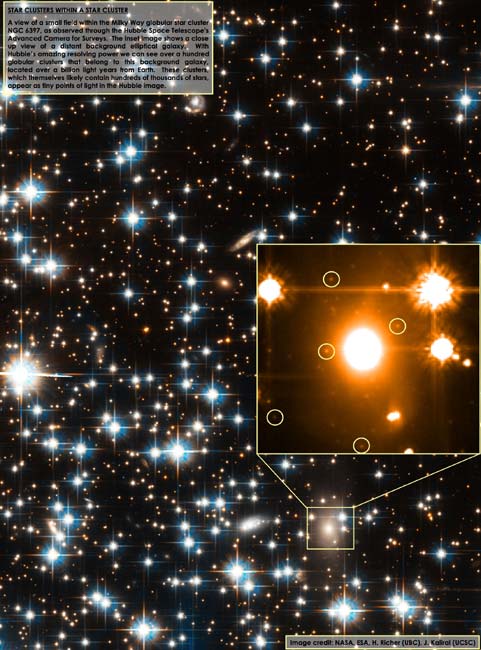
SEATTLE - The most distant star cluster astronomers have everobserved has been found behind one of the nearest clusters to Earth.
While using the Hubble Space Telescope tostudy NGC 6397, a star cluster located only 8,500 light-years away, researchersspotted a background elliptical galaxy whose light peeked through the nearbycluster [image].
The distant galaxy containsseveral hundred globular star clusters, each probably containing hundreds ofthousands of stars. The newfound galaxydoes not have a name yet.
"Often in these deepimages, one finds many distant galaxies, most of which will never havenames," said study team member Jason Kalirai, a postdoctoral fellow at theUniversity of California, Santa Cruz.
Kalirai and his colleague,Harvey Richer of the University of British Columbia in Canada, followed up onthe Hubble images by analyzing the light signature of the distant clustersusing the Gemini South Telescope in Chile.
By measuring how much lightfrom the distant galaxy has been stretched during its journey across theuniverse, a phenomenon called "redshift,"the researchers determined that it was located about a billion light-years away,making the star clusters in the galaxy some of the most distant ever studied.
"The largestsubstantial population--say more than 100--of star clusters in any other galaxyis located about 10 times closer than this object," Kalirai told SPACE.com.
Breaking space news, the latest updates on rocket launches, skywatching events and more!
The star clusters are sofar away, in fact, that they are about 10 million times dimmer than a singlegiant star in NGC 6397. The findings were detailed here today at the 209thmeeting of the American Astronomical Society.
Clues about our owngalaxy
According to some theories,globular star clusters are thought to provide the bulk needed to form ellipticalgalaxies. The newly spied star clusters will provide scientists with a way totest those theories.
"Theclusters can shed light on the evolution and formation of galaxies,"Kalirai said. For example, astronomers can infer the ages and metal contents ofthe stars in the clusters based on their colors. Combining this informationwith the clusters' locations can tell astronomers when certain parts of thegalaxy formed.
"Forspiral galaxies like the Milky Way,the globular clusters directly tell us when the haloformed and, since this is the first component to form, when the galaxy itselfformed," Kalirai said in an e-mail interview.
The distantgalaxy could also provide a baseline for studying the evolution of clustersin our own Milky Way.
"Thisgalaxy is far enough at a distance of 1 billion light-years that the light fromthese clusters has taken a billion years to reach us," Kalirai explained."So, if all of these systems are old, then we are essentially probingyounger cousins of our own globular population."
Editor'sNote: Allweek, SPACE.com is providing completecoverage of the 209th meeting of the American Astronomical Society.
- Speedy Discovery Fuels New Milky Way Mystery
- IMAGES: Amazing Galaxies
- VIDEO: Our Corner of the Cosmos
- All About Galaxies
Ker Than is a science writer and children's book author who joined Space.com as a Staff Writer from 2005 to 2007. Ker covered astronomy and human spaceflight while at Space.com, including space shuttle launches, and has authored three science books for kids about earthquakes, stars and black holes. Ker's work has also appeared in National Geographic, Nature News, New Scientist and Sky & Telescope, among others. He earned a bachelor's degree in biology from UC Irvine and a master's degree in science journalism from New York University. Ker is currently the Director of Science Communications at Stanford University.
